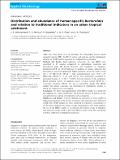Distribution and abundance of human-specific
Author(s)
Nshimyimana, Jean Pierre; Ekklesia, E.; Shanahan, Peter; Chua, L. H. C.; Thompson, Janelle Renee
DownloadNshimyimana-2014-Distribution and abundance.pdf (1.019Mb)
PUBLISHER_CC
Publisher with Creative Commons License
Creative Commons Attribution
Terms of use
Metadata
Show full item recordAbstract
Aims:
The study goals were to determine the relationship between faecal indicator bacteria (FIB), the HF183 marker and land use, and the phylogenetic diversity of HF183 marker sequences in a tropical urban watershed.
Methods and Results:
Total coliforms, Escherichia coli, and HF183 were quantified in 81 samples categorized as undeveloped, residential and horticultural from the Kranji Reservoir and Catchment in Singapore. Quantitative-PCR for HF183 followed by analysis of variance indicated that horticultural areas had significantly higher geometric means for marker levels (4·3 × 104 HF183-GE 100 ml−1) than nonhorticultural areas (3·07 × 103 HF183-GE 100 ml−1). E. coli and HF183 were moderately correlated in horticultural areas (R = 0·59, P = 0·0077), but not elsewhere in the catchment. Initial upstream surveys of candidate sources revealed elevated HF183 in a wastewater treatment effluent but not in aquaculture ponds. The HF183 marker was cloned, sequenced and determined by phylogenetic analysis to match the original marker description.
Conclusion:
We show that quantification of the HF183 marker is a useful tool for mapping the spatial distribution and potential sources of human sewage contamination in tropical environments such as Singapore.
Significance and Impact:
A major challenge for assessment of water quality in tropical environments is the natural occurrence and nonconservative behaviour of FIB. The HF183 marker has been employed in temperate environments as an alternative indicator for human sewage contamination. Our study supports the use of the HF183 marker as an indicator for human sewage in Singapore and motivates further work to determine HF183 marker levels that correspond to public health risk in tropical environments.
Date issued
2014-05Department
Massachusetts Institute of Technology. Department of Civil and Environmental EngineeringJournal
Journal of Applied Microbiology
Publisher
John Wiley & Sons, Inc
Citation
Nshimyimana, J. P., E. Ekklesia, P. Shanahan, L. H. C. Chua, and J. R. Thompson. “ Distribution and Abundance of Human-Specific Bacteroides and Relation to Traditional Indicators in an Urban Tropical Catchment .” Journal of Applied Microbiology 116, no. 5 (February 25, 2014): 1369–1383.
Version: Final published version
ISSN
13645072